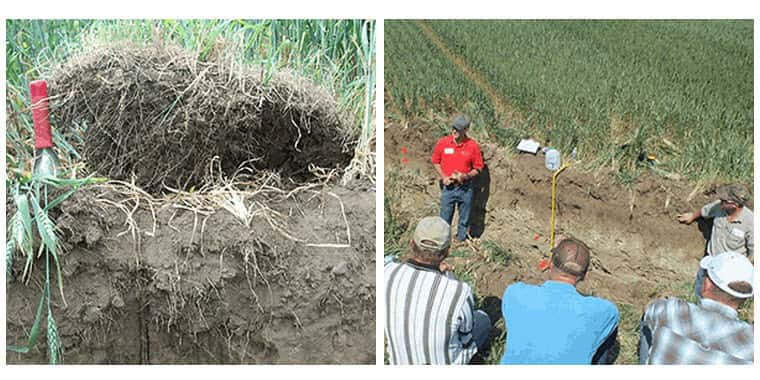by Andy Johnsrud, District Conservationist, Scobey
and Mark Henning, Area Agronomist, Miles City
Last July, Charlie Cahill, a farmer in Daniels County, hosted a crop tour with about 100 people in attendance. Producers split into five groups and rotated through different educational stations. One of these stations was a soil pit, requested by Charlie, with an emphasis on soil health demonstrated by Miles City Area Agronomist, Mark Henning and Scobey District Conservationist, Andy Johnsrud. The pit was a hit! Tour evaluations said it was the most beneficial of all the tour stops.
The field in which we dug the pit was enrolled in the Conservation Reserve Program (CRP) until 2013. It was planted to a cover crop in 2014, and was a wheat trial plot this year (2015). Because the trial plot planter was by no means a no-till drill, they had to cultivate the area four times to allow for uniform seeding. This was perfect for the soil pit, as we were able to demonstrate how detrimental the “one time smoothing out” CRP conversion process can be. We also took a backhoe-bucketfull of soil from a CRP field directly adjacent for comparison. You could definitely see a difference in carbon content as indicated by the difference in soil color – the CRP sample was darker than the wheat profile. Just the “one time deal” of smoothing/working the field and converting to an annual cropping system reduced the amount of carbon in the soil. It was a very good visual. An infiltration ring test showed that water infiltrated the converted CRP land at a rate of 29 inches per hour, while the infiltration rate of the neighboring CRP land was 45 inches per hour. Also, in this dry year we found wheat roots down four feet. The sandy soil on this site (57-Turner sandy loam) is only capable of holding about 3.5 inches of water in the top four feet. Farmers were very familiar with the challenges of raising crops on this soil, and most, if not all, were no-tillers; but the soil pit emphasized the importance of building organic matter to build water holding capacity.
Take home lessons?
1. You will always pay a price in lost carbon and infiltration capacity when you till the soil. Systems with low crop diversity and high tillage will mine carbon from the soil, leading to decreased productivity. Which, as Andy pointed out to the farmers, is why many acres of Turner sandy loam went into CRP.
2. Perennial systems are better at getting and keeping carbon in the ground. Therefore seek to mimic perennial systems in your cropping system: no-till, diversity, roots in the ground more days of the growing season, and keeping the soil covered. Carbon is the most limiting nutrient, so managing it is critical.
3. Consider adding a perennial sequence to your annual crop rotation.
Many of the attendees are already very progressive in their diverse, no-till systems with low disturbance drills. But the soil pit demonstration challenged them to think about how they can further develop those systems to enhance their stewardship of the land.
CLICK HERE for more information
Source; Montana NRCS
Photos by Mark Henning and Jennifer Cahill


